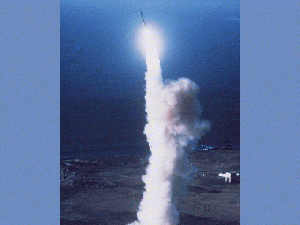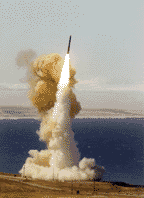  |
Right: Another shot of a MM III launch.
NOTE: The larger shot you get when you click on that thumbnail is black & white. (USAF photo)
  |
The Minuteman (MM) concept originated in the late 1950's and early '60's. It was the first solid-fueled
missile to enter service, giving it a large margin of improvement over the earlier ICBMs such as the
LGM-25C Titan II liquid-fuelled ICBM. The fact that the MM is solid-fuelled gives a much higher reliability
rate, easier maintenance and longer storage times. Since the fuel is ready to go, unlike a liquid-fuelled
ICBM whose fuel requires extensive preparation before launch, the MM can be launched within seconds of the
launch keys being turned. The original Minuteman I, the LGM-30A, entered USAF service in 1962. It carried a
single W59 nuclear warhead with a yield of 1MT. The Minuteman II, the LGM-30F, became operational in 1965, and
carried one 1.2MT W56 nuclear warhead.
Currently, there are a total of 530 Minuteman IIIs in the USAF inventory (All MM Is and MM IIs are out of service). They are based
Warren AFB in Wyoming; Minot AFB, North Dakota; Grand Forks AFB, N.D.; Minot AFB, N.D.; and Malstrom AFB, Montana. Currently the USAF is
removing the 150 MM IIIs at Grand Forks AFB, and transferring them into converted MM II silos at Malstrom AFB. This will reduce the number
of Minuteman bases from 4 to 3 by April 1998. In accordance with the START II treaty, the LGM-118A Peacekeeper ICBM will be taken out of service,
leaving the Minuteman III as the only land-based ICBM in the Nuclear Triad. This treaty also means that the number of warheads the MM III carries will be reduced
from 3 to 1.
A program called Rivet Mile is in progress to repair and slow the effects of aging on the missiles. Also, the REACT (Rapid Execution And Combat Targeting) program
was initiated in
1989, modifying the launch control centers, improving communications and weapons status equipment, as well as improving the missile's
rapid retargeting characteristics. Also, the possibility of modifying 20 MM IIIs with defensive kinetic-kill vehicles for anti-missile defense is being evalutated. These and
other programs ensure that the Minuteman III will be in service through 2020.
The LGM-30G Minuteman III Model 1was first loaded into a silo assigned to the 741st Strategic
Missile Squadron (SMS) at Minot AFB, North Dakota on April 17, 1970. In December the 741st SMS achieved operational
status with the LGM-30G. The LGM-30G Minuteman III Model 2 entered service in 1979 and included improved penetration aids such chaff and
decoys, to increase the chances of the missile's payloads reaching their targets.
The MM III has 3 stages. The first stage, which has a diameter of 5 ft 6 in (1.8m), has a Thiokol M55A1 solid-fuel rocket engine delivering
202,600 lb st. (901.21 kN) thrust. The second stage has an Aerojet-General AR19-AJ-1 solid-fuel rocket delivering 60,625 lb st. (269.67kN)
thrust, and the third stage has a Thiokol SR73-AJ-1 solid rocket delivering 33,800 lb st. (150.34kN). The Post-Boost Vehicle (PBV) has a Bell
Aerospace rocket with 315 lb st (1.40kN). All told this allows the MM III to deliver its warheads up to 8,700 miles (14,400 km).
The MM III's guidance package consists of an Inertial system from the Autonetics Division of Rockwell International. The LGM-30G's PBV
contains a warhead bus which holds 3 Multiple Independent Re-entry Vehicles (MIRVs) which are deployed from the PBV after the nose shroud
has been released. The 3 warheads can either be 170kT W62 warheads contained in General Electric (GE) Mk 12 RVs, which can be delivered with a
Circular Error Probability (CEP) of 300 yards (275m); or of 335kT W78 warheads contained in GE Mk 12A RVs, which the MM III can deliver with
a CEP of 240 yards (220m). The launch of the missile is controlled by 2 USAF launch officers in a launch control facility approximately 50 ft underground.
| Manufacturer | Boeing Aerospace Company |
| Missile Length | 55 ft 10 in (18.31m) |
| Missile Diameter | 5 ft 6 in (1.8m) |
| Launch Weight | 79,432 lbs (36,062 kg) |
| Speed at burnout | Approx 15,000 mph (Mach 23) |
| Max ceiling | Approx 700 miles (1,130 km) |
| Maximum range with payload | 8,700 miles (14,000 km) |
| Propulsion | 1st stage: 1x Thiokol M55A1 solid rocket with 202,600 lb st. (901.21kN) thrust; 2nd stage: 1x Aerojet-General SR19-AJ-1 solid rocket with 60,625 lb st. (269.67kN); 3rd stage: 1x Thiokol SR73-AJ-1 solid rocket with 33,800 lb st. (150.34kN) thrust; PBV: 1x Bell Aerospace bi-propellant rocket with 315 lb st. (1.4kN) thrust |